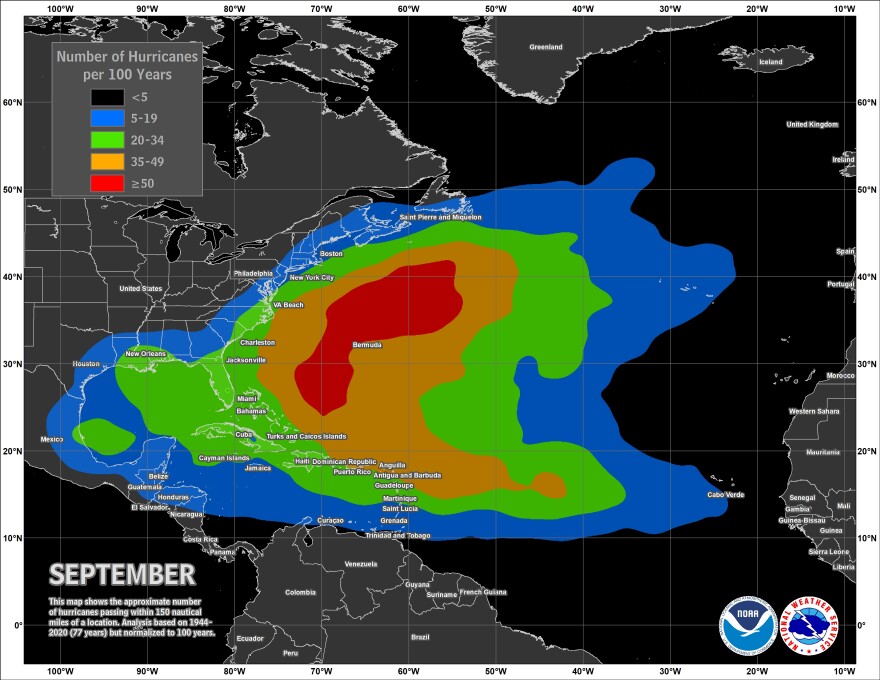BETHLEHEM, Pa. – Record-warm ocean temperatures are likely to fuel the peak of hurricane season, scientists at the National Oceanic and Atmospheric Administration said Thursday.
For that reason, they’re now predicting a 60% chance of an above-normal Atlantic hurricane season, with 14 to 21 named storms, 6 to 11 hurricanes (winds 74 mph or greater) and 2 to 5 major hurricanes (winds 111 mph or greater).
- NOAA scientists have adjusted predictions for the remainder of hurricane season
- They're now predicting a 60% chance of an above-normal season, with 14 to 21 named storms, 6 to 11 hurricanes and 2 to 5 major hurricanes
- They said record ocean temperatures are a big factor in the adjustment
A normal year would have 14 named storms, seven hurricanes and 3 major hurricanes.
It comes months after NOAA predicted a “near-normal” hurricane season, meaning the revision decreased the likelihood of near-normal activity to 25% from the 40% chance announced in May.
Forecasters believe that current ocean and atmospheric conditions, including the record-warm Atlantic sea surface temperatures, are likely to counterbalance any limiting atmospheric conditions, such as the ongoing El Nino event.
“Considering those factors, the updated outlook calls for more activity, so we urge everyone to prepare now for the continuing season,” Matthew Rosencrans, the lead hurricane season forecaster with NOAA’s Climate Prediction Center, said during a media briefing Thursday.
Activity could extend beyond the season
The revised outlook covers the remainder of the six-month hurricane season, which begins on June 1 and ends on Nov. 30.
But it’s not uncommon for activity to extend beyond that window, David Manning, Meteorologist-in-Charge for the National Weather Service’s Eastern Region Regional Operations Center, told LehighValleyNews.com on Aug. 1.
“One thing that we have seen is that we are filling out the hurricane season a lot more," Manning said. "We’re seeing earlier storms in the year, and we're seeing some even later in the year.

“You can go back a few years, and we had storms into December and even in January, several years ago. So the conditions when they come together, we can have a tropical cyclone at any time in the Atlantic basin, as long as the ingredients are in place. So that season is less of a factor than the ingredients.”
It could be a disconcerting thought to Lehigh Valley residents impacted by Sandy on Oct. 29-30, 2012. The ‘superstorm’ knocked out power to hundreds of thousands of people in and around the Lehigh Valley – some for two weeks or more.
Area residents also dealt with Tropical Storms Fay and Isaias in 2020, and the remnants of Hurricane Ida in Sept. 2021.
It means that we'll have to keep an eye on any tropical development over the next several months for impacts to this area.
‘We’re just as at-risk’
“Hurricanes today are developing faster and intensifying more rapidly than they have in the past. We’re seeing more tornadoes across the mid-Atlantic than we have in the past as well as increased risk of inland flooding far from the coast,” FEMA Region 3 Regional Administrator MaryAnn Tierney recently told LehighValleyNews.com.
“I do think that the increasing amount of storms and the different types of hazards that we are facing will continue and will likely increase,” she said.
Tierney said her main worry when it comes to severe weather is “apathy” and residents in the Mid-Atlantic region not being prepared.
“My big concern is the public not being concerned about hurricanes and not being ready for them … we're just as at-risk as areas in the southern part of the United States.”
The estimates from NOAA are for the total number of storms expected to form during hurricane season, but are not forecasts of the number of storms expected to make landfall. Current models are only effective for predicting potential landfall starting about one week out, Rosencrans said.
He urged everyone to prepare for a potential storm now, and pointed to emergency preparedness tips at Ready.gov. He said everyone should prepare early and have a plan for what to do in case a hurricane hits the area.


